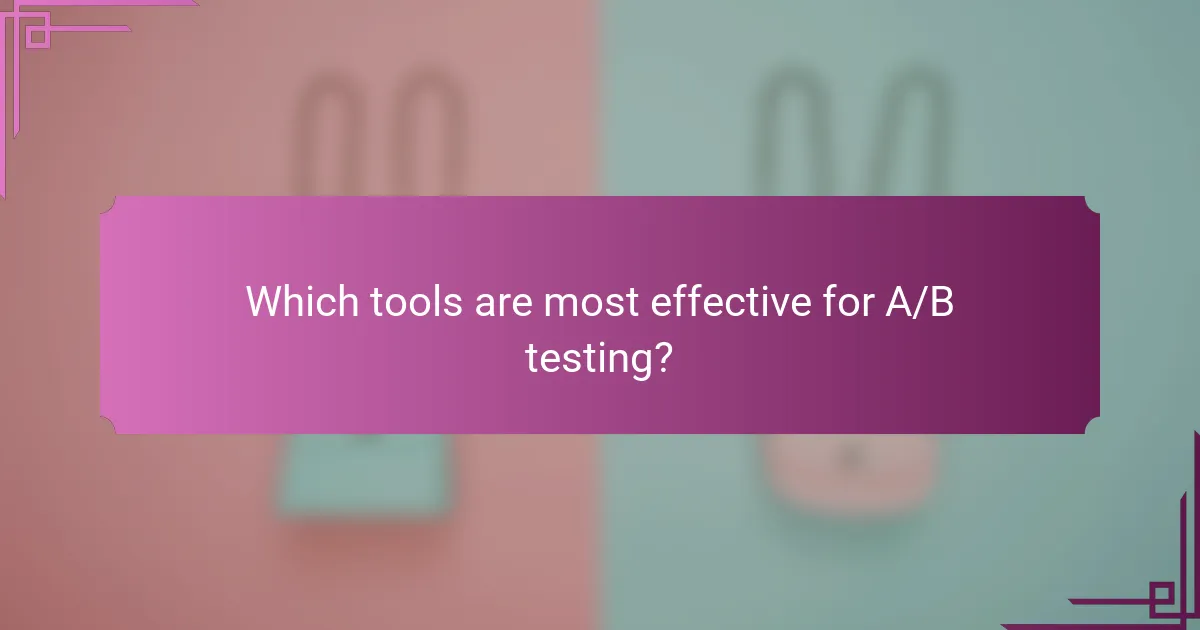A/B testing is a powerful technique that enables marketers to optimize their display advertising by comparing different ad variations to determine which one engages their audience most effectively. By leveraging methods such as split URL testing and multivariate testing, marketers can enhance campaign performance based on real user interactions. Utilizing the right A/B testing tools not only simplifies the testing process but also provides valuable insights that drive better results and higher returns on investment.

How can A/B testing improve display advertising performance?
A/B testing can significantly enhance display advertising performance by allowing marketers to compare different ad variations and identify which one resonates best with their audience. This method helps optimize campaigns based on real user interactions, leading to better results and higher returns on investment.
Increased conversion rates
One of the primary benefits of A/B testing is its ability to boost conversion rates. By testing different elements such as headlines, images, and calls to action, advertisers can determine which combinations lead to more users completing desired actions, like making a purchase or signing up for a newsletter.
For instance, a simple change in the color of a call-to-action button can lead to conversion rate increases of 10-30%. Regularly conducting A/B tests ensures that display ads are continually optimized for maximum effectiveness.
Enhanced user engagement
A/B testing also fosters enhanced user engagement by allowing marketers to tailor their ads to better meet audience preferences. By analyzing user interactions with different ad formats or messaging, advertisers can create more relevant and appealing content.
For example, testing various ad placements on a webpage can reveal which positions yield higher click-through rates. Engaging ads not only attract more clicks but also encourage users to spend more time interacting with the brand.
Data-driven decision making
Using A/B testing promotes data-driven decision making, which is crucial for effective advertising strategies. By relying on actual performance data rather than assumptions, marketers can make informed choices that lead to improved outcomes.
Establishing a systematic approach to A/B testing involves setting clear objectives, defining key performance indicators, and analyzing results rigorously. This method reduces guesswork and helps allocate budgets more effectively, ensuring that resources are directed toward the most successful ad variations.

What are the best A/B testing methods for display ads?
The best A/B testing methods for display ads include split URL testing, multivariate testing, and sequential testing. Each method offers unique advantages and considerations that can significantly impact the effectiveness of your advertising campaigns.
Split URL testing
Split URL testing involves creating two or more distinct URLs for different versions of an ad to measure performance. This method is particularly useful for testing major changes, such as different layouts or entirely different messaging.
When implementing split URL tests, ensure that traffic is evenly distributed among the variations to obtain reliable results. A common approach is to use a 50/50 split for two versions, but you can adjust this based on your audience size and testing goals.
Multivariate testing
Multivariate testing allows you to test multiple variables simultaneously within a single ad. This method helps identify the best combination of elements, such as images, headlines, and calls to action, to optimize performance.
For effective multivariate testing, ensure you have a sufficient sample size to yield statistically significant results. This method can be more complex and requires careful planning, as the number of combinations increases exponentially with each additional variable.
Sequential testing
Sequential testing involves running tests in a series rather than simultaneously. This method is useful when you want to test changes over time, allowing you to analyze results before moving on to the next variation.
While sequential testing can provide clear insights, it may take longer to reach conclusions compared to other methods. Be mindful of external factors that could influence results over time, and ensure that your testing periods are consistent to maintain accuracy.

Which tools are most effective for A/B testing?
Effective A/B testing tools help marketers and product teams optimize their websites and applications by comparing variations of content to determine which performs better. The right tool can streamline the testing process, provide insightful analytics, and enhance overall performance.
Google Optimize
Google Optimize is a free tool that integrates seamlessly with Google Analytics, allowing users to run A/B tests and personalize user experiences. It offers a user-friendly interface and robust targeting options, making it suitable for both beginners and advanced users.
When using Google Optimize, consider leveraging its visual editor to create variations without needing extensive coding knowledge. However, be mindful of the limitations in advanced features compared to paid tools, which may restrict complex testing scenarios.
Optimizely
Optimizely is a leading A/B testing platform known for its powerful capabilities and flexibility. It provides a comprehensive suite of tools for experimentation, including multivariate testing and personalization features, which can significantly enhance user engagement.
While Optimizely offers extensive functionality, it comes at a higher price point, making it more suitable for larger organizations with dedicated budgets for optimization. Users should ensure they have a clear strategy and objectives before investing in this tool to maximize its potential.
VWO
VWO (Visual Website Optimizer) is another popular A/B testing tool that focuses on usability and insights. It provides features such as heatmaps, session recordings, and detailed reporting, which help teams understand user behavior and make informed decisions.
VWO is particularly beneficial for teams looking to combine A/B testing with qualitative data analysis. However, users should be cautious of its learning curve, as mastering all features may require time and training. Prioritize key tests that align with your business goals to ensure effective use of the platform.

What insights can be gained from A/B testing?
A/B testing provides valuable insights into user preferences, behavior, and the effectiveness of different strategies. By comparing two or more variations, businesses can identify which elements drive better performance and enhance overall user experience.
User behavior analysis
User behavior analysis through A/B testing reveals how different design elements or content variations influence user actions. For instance, changing a call-to-action button’s color may lead to increased clicks. Tracking metrics such as time spent on page and bounce rates can help determine which version resonates more with users.
To effectively analyze user behavior, consider segmenting data by demographics or device types. This allows for a deeper understanding of how different audiences interact with variations, leading to more tailored strategies.
Ad performance metrics
A/B testing is crucial for evaluating ad performance metrics, such as click-through rates (CTR) and conversion rates. By testing different ad formats, headlines, or images, businesses can pinpoint which combinations yield the highest engagement. For example, a simple change in wording can result in a significant increase in CTR.
When analyzing ad performance, focus on key performance indicators (KPIs) relevant to your goals. Regularly reviewing these metrics can help refine ad strategies and allocate budgets more effectively.
Audience segmentation
Audience segmentation in A/B testing allows businesses to tailor their approaches based on specific user groups. By testing variations on different segments, such as age or geographic location, companies can identify preferences and optimize their messaging. For instance, younger audiences may respond better to vibrant visuals, while older demographics might prefer straightforward content.
Utilize tools that enable detailed segmentation analysis, ensuring that insights gained from A/B tests are actionable. This targeted approach can lead to improved engagement and higher conversion rates across diverse audience segments.

What criteria should be considered when selecting A/B testing tools?
When selecting A/B testing tools, consider ease of use, integration capabilities, and cost-effectiveness. These criteria ensure that the tools not only meet your technical requirements but also fit seamlessly into your existing workflows and budget.
Ease of use
Ease of use is crucial for effective A/B testing. Tools should have intuitive interfaces that allow users to set up tests quickly without extensive training. Look for platforms that offer drag-and-drop functionality and clear navigation.
Additionally, consider the availability of tutorials and customer support. A tool that provides comprehensive documentation and responsive support can significantly reduce the learning curve and help troubleshoot issues efficiently.
Integration capabilities
Integration capabilities determine how well an A/B testing tool works with your existing software stack. Ensure that the tool can seamlessly connect with your analytics platforms, content management systems, and customer relationship management software.
Tools that support APIs or have pre-built integrations can save time and reduce errors during data transfer. Check if the tool can integrate with popular platforms like Google Analytics, Shopify, or WordPress to enhance your testing capabilities.
Cost-effectiveness
Cost-effectiveness is a key factor when choosing A/B testing tools. Evaluate the pricing models, which may include monthly subscriptions, pay-per-test, or tiered pricing based on usage. Choose a model that aligns with your budget and testing frequency.
Consider the potential return on investment (ROI) from using the tool. A more expensive tool might offer advanced features that lead to better insights and improved performance, ultimately justifying the cost. Compare several options to find the best balance between features and price.

How to interpret A/B testing results?
Interpreting A/B testing results involves analyzing the data to determine which variant performs better based on predefined metrics. Key factors include statistical significance, confidence intervals, and actionable insights derived from the results.
Statistical significance
Statistical significance indicates whether the results observed in an A/B test are likely due to chance or reflect a true difference in performance. A common threshold for significance is a p-value of less than 0.05, suggesting that there is less than a 5% probability that the observed differences occurred randomly.
When interpreting significance, consider the sample size; larger samples can yield more reliable results. If the p-value is above the threshold, it may be prudent to gather more data before making decisions.
Confidence intervals
Confidence intervals provide a range within which the true effect size is likely to fall, offering insight into the precision of the estimated results. A 95% confidence interval is standard, meaning you can be 95% confident that the true difference lies within this range.
For example, if the confidence interval for a conversion rate difference is 2% to 8%, you can infer that the actual impact of the change could be anywhere from a 2% increase to an 8% increase in conversions. Wider intervals indicate less certainty, so aim for a balance between sample size and desired precision.
Actionable insights
Actionable insights are the practical conclusions drawn from A/B testing results that inform decision-making. These insights should be specific and tied to the metrics you aimed to improve, such as conversion rates or user engagement.
To derive actionable insights, analyze not just which variant performed better, but also why it performed better. Look for patterns in user behavior, and consider segmenting data by demographics or device types to uncover deeper insights. Avoid jumping to conclusions without sufficient evidence, and ensure that insights are aligned with your overall business objectives.

